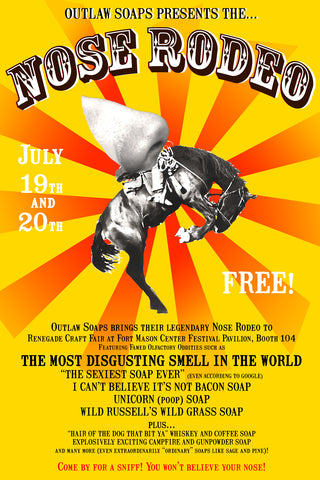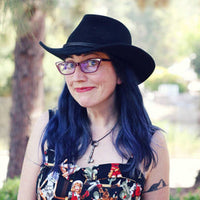This post was originally published in 2014. It is still true, and still interesting. So we're republishing it.
This question is from Cindy Emch from our call for blog topics.
If you are a handmade soap or lotion manufacturer and you're reading this, please consult our FAQ section regarding competitive knowledge.

Did you know you can make anything smell like anything?
When we first started our handmade soap business, we weren't remotely tied to traditional scents. As long as they didn't smell bad, we were open to anything!
We started ordering samples en masse, collecting these single-oz bottles of smelly stuff by the boxload. So we have smelled A LOT of things I thought weren't possible.
The descriptions of the fragrances are super weird, too, giving almost zero information about the actual product. For example, here's "Sands of Morocco":
"Classic carnation blended with warm, powdery sandalwood and musk.
Scent is one of the most powerful of our five senses. Smelling a fragrance can trigger a treasured memory and provoke enjoyable thoughts. When designing products, consider how your customers will use your products. Will they be washed off? Will they be used to fragrance a home? Will they be used in conjunction with other products and how will those scents smell when combined? Consider complimenting your scent with coordinating colors."
Gee, thank you.
This could smell like almost anything, but I can pretty much guarantee that it doesn't smell like sandalwood and musk. It probably smells like perfume. Because EVERYTHING smells like perfume in these blends.
Let's start with the UGLY:
These were so bad that they almost put us off of smelling things forever.
- Pot roast. Yes, pot roast. (it was the most disgusting smell in the world at the Nose Rodeo)
- 90% of the lavender scents out there
- Vanilla sandalwood (smelled like plastic)
- Bacon... yeah, but I don't mean the bacon we use. There were a lot of bacons that we smelled and wanted to bury in the ground.
- Any number of cologne-type blends. They all smell like Drakar Noir.
Moving on to the BAD:
These were 60% ok, but needed work. When we got these kind of scents, we usually blended them with other scents to round out wherever the scents were lacking.
- Firewood. It just didn't really smell like campfire. I mean, there was a smokiness, but it just wasn't quite right there. Blended with another campfire, though, it rounds out and becomes just right.
- Bacon. Yeah, the bacon we use needs to be cut with some other scents so it's not so... meaty.
- Gunpowder. Even spot on, I think gunpowder is too acidic-smelling by itself.
- Fuel / Gasoline / Oil. DON'T EVEN GET ME STARTED. This is pretty much the #1 smell I want to make in a bar... car shop smell, cedar shavings, a little pine... it's the smell of my friend Jet's driveway and it smells AH-MAY-ZING. But Russ says no one would buy it, and as I will discuss later, if Russ says it's not going to sell, it probably won't.
- Nature blend scents. There's one I have in a bottle on the dryer called "Sky By Night" or something like that. I personally think it has potential, but Russ says it's too floral. I think if we add a little grass or sandalwood, it would make it less fru-fru, but we kind of don't do fru-fru even a little, so ... :(
- Coffee. WHY CAN WE NOT GET A GOOD COFFEE AROUND HERE? The coffee we use is the best we could find -- not too sweet, not too bitter. Smells a little like chocolate. Somehow every scent manufacturer in the world thinks coffee should smell like straight sugar. BLECK. Oh, and we DID have a great coffee, but the manufacturer changed the base and it no longer smelled like anything in the soap. Nothing. So we had 25 lbs of unscented liquid... because these companies don't take returns.
And HOORAY! The GOOD:
These are scents that we immediately knew we had to use in almost everything we made. They represented the fundamental scents of the West, and form the cornerstone of our products
- Desert Sage. How could we live without this foundational piece? Almost every one of our handmade soaps and lotions includes the dusty perfection that is our desert sage. We smelled probably 6 - 10 samples of sage before we found THE ONE.
- Sandalwood. Like Desert Sage, we smelled samples high and low. We didn't want a sandalwood that was too musky or too ... tangy? Is that a smell? Anyways, we found a lot of sandalwoods that smelled kind of sour. Not ours. Ours is smooth, silky, and delightful.
- Campfire. When we found a good campfire, it was like a bolt came out of the sky and punched me in the nose with all the memories of camping all the way back to Girl Scouts. We cut our campfire with the crackling firewood to give it a little sweetness, but straight-up, the campfire is so spot-on you'd think you were camping.
- Leather. When we found the leather scent, it was one of those we just kind of made the soap around. I ordered the sample out of curiosity, and the smell was so spot-on that Russ went off and made Blazing Saddles (the sexiest soap ever) straight away.
There are of course MULTITUDES of other scents in our shop (fresh cut grass, whiskey, etc), but these are the Good, The Bad, and the Ugly.
Fragrances are tricky things, and our sources are pretty much the only "trade secret" we have. We're so sensitive about our sources that we re-bottle everything and turn the labels away when photographers come. We have told all our photographer friends that they can photograph anything... except the fragrances.
When we got started, oh, I feel bad for the people I worked with. They had to endure me smelling like pretty much any ol' smell I could get my hands on, including maple donut.
But these days, we don't test out many new scents. We try to stick with what we have. Why? It's expensive to order samples if we're not sure they're going to work out. So if we want to create a gin and tonic soap, we first have to order every gin scent and every tonic scent, and then try them in different formulas, and THEN try those in soap. Just product development alone can cost hundreds of dollars (like the Firefox soaps... phew!).
If you're curious about why we use fragrances instead of essential oils, please see our page on Ingredients & Process.




